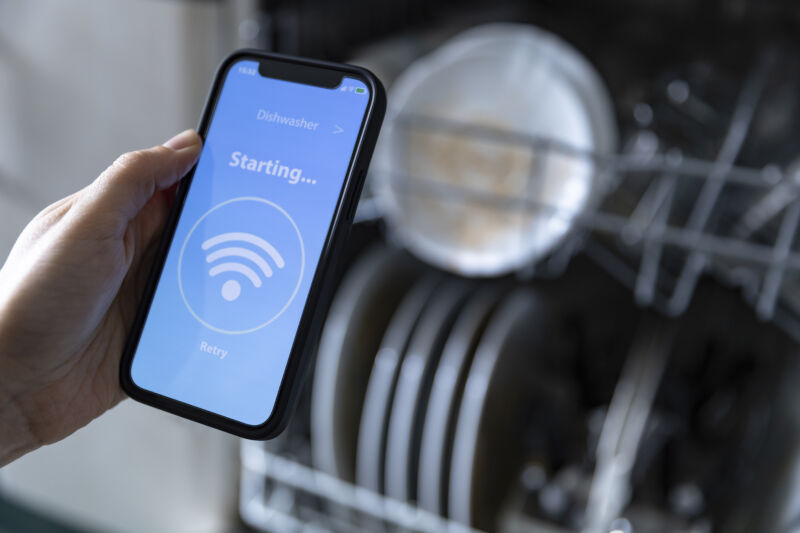Credit to: ars Technica, written by Kevin Purdy
Did users change their Wi-Fi password, or did they see the nature of IoT privacy?
Enlarge / This hypothetical dishwasher owner is one of a minority of smart appliance customers getting the full value of their device, including timely reminders to buy more of the company’s recommended dishwasher tabs and cleaning packs.
Appliance makers like Whirlpool and LG just can’t understand. They added Wi-Fi antennae to their latest dishwashers, ovens, and refrigerators and built apps for them—and yet only 50 percent or fewer of their owners have connected them. What gives?
The issue, according to manufacturers quoted in a Wall Street Journal report (subscription usually required), is that customers just don’t know all the things a manufacturer can do if users connect the device that spins their clothes or keeps their food cold—things like “providing manufacturers with data and insights about how customers are using their products” and allowing companies to “send over-the-air updates” and “sell relevant replacement parts or subscription services.”
“The challenge is that a consumer doesn’t see the true value that manufacturers see in terms of how that data can help them in the long run. So they don’t really care for spending time to just connect it,” Henry Kim, US director of LG’s smart device division ThinQ, told the Journal.
LG told the Journal that fewer than half of its smart appliances—which represent 80–90 percent of its sold appliances—stay connected to the Internet. Whirlpool reported that “more than half” are connected. Wi-Fi-connected smart appliances may be connected when they’re first set up, but a new Internet provider, router hardware, or Wi-Fi password could take the device offline. And a smart oven is likely to be far down the list of devices to set up again once that happens.
That means companies like Whirlpool are missing out on services revenue, which is increasingly crucial to manufacturers facing rising input costs, declining replacement purchases, and hungry shareholders. Whirlpool acquired recipe management app Yummly in 2017, and its customers can sync a Yummly Pro subscription to a smart oven so that it follows the recipe’s instructions (which must, apparently, sometimes go beyond “heat to this level”).
For its part, LG saw an incremental increase in water-filter sales when it tracked water volumes on connected fridges versus non-connected fridges, the company told the Journal. Both companies also suggested that new features, including safety alerts, are issued to connected customers.
Whirlpool told the Journal that customers “have the opportunity to opt in or opt out” of sharing data with the company. LG doesn’t offer that option, but Kim told the Journal that “all data is anonymized.”
While the manufacturers blame technical constraints, some customers may simply not want to provide companies with vague privacy policies or bad histories with security access to their networks.
LG smart TVs were found in 2013 to be uploading extensive data to their servers about all the activity happening on them, including watching files on USB sticks. At the time, LG admitted it was collecting this data, but it suggested the data was “not personal” and was used only for advertisement targeting or as part of software projects that were discontinued. LG is far from the only TV maker to participate in automated content recognition, but it’s one of a select few that also makes a dishwasher.
More broadly, smart home (or Internet of Things, or IoT) devices are too often built with an “acquire, upload, whatever” mindset. Take the test models from iRobot/Roomba (up for potential acquisition by Amazon) that uploaded images of someone on the toilet to the cloud. Or any of the dozens of devices detailed in an Institute of Electrical and Electronics Engineers study, a Northeastern/Imperial College survey, or the Mozilla Foundation’s “Privacy Not Included” list. The problems are so widespread and varied that the White House has called for universal IoT security labeling.
Appliance makers are eager for buyers to connect their smart devices, but at least some may think they’ve done the smart thing by letting them work offline.
Credit to: ars Technica, written by Kevin Purdy

